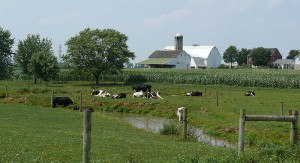
Agricultural Industry Must Adapt to Rapid Climate Change
The United States agricultural industry produces approximately $300 billion a year in commodities, all of which comes from 2 million farms that cover 900 million acres across the country. According to a report released by the USDA this month, climate change is predicted to deeply affect this key industry and American national security if we do not find new ways to adapt.
The report says there are two ways that climate change can affect agriculture; directly and indirectly. Directly, agriculture is affected by air temperatures because crops can only prosper within certain temperatures. Precipitation levels also affect agriculture because precipitation is either increasing or decreasing in certain areas making it harder for farmers to determine when to deliver water to their crops. Rising temperatures are also changing the amount of water these crops need. Raised CO2 levels are also affecting crops and stimulating photosynthesis, though the relationship between the two factors remains unclear. Scientists are now investigating this relationship.
Indirect effects on agriculture include increased weed intensity, elevated levels of pests, and pathogens. These are indirect effects because climate change creates the conditions necessary for these factors to in turn negatively affect agricultural yields.
The increasing temperatures, amount of carbon, and the changing precipitation patterns will continue to affect crops in the near and long-term. Livestock will in turn have to adjust to rising temperatures by changing their internal temperatures. Doing so will change the amount these animals produce and could even result in the death of livestock.
The agricultural industry has experienced a good 150 years of steady climate changes that have allowed it to slowly adapt in turn. However, with increasing levels of anthropogenic climate change, the old methods of adaption will no longer do. Furthermore, adaptation alone will not be enough, it is important to reduce the amount of greenhouse gases humans emit as well.
According to the USDA report, adaptation in the agricultural sector can only be effective if decision makers and stakeholders have the right information, knowledge, and tools to deal with climate change. To make adaptation more effective, research and development efforts are underway. These efforts are to help policy makers understand the vulnerability of these systems and allow the best possible adaptation efforts to move forward.
It is not only the U.S. agricultural industry that will be affected by rapid climate change and severe weather events, rather the entire global agricultural industry will be affected.
The report acknowledges that developing countries will have less of an ability to adapt to climate change, which could have significant effects on global hunger and well-being. Weather patterns could negatively affect certain areas while positively affecting others, changing the global market.
The increasing changes to weather patterns and rapid man-made climate change makes it difficult for the agriculture industry to adapt in ways that it could before. These changes allow for an uncertainty that this industry is not prepared for. Research and development, adaptation, and the tools to adapt are all essential in ensuring that the agricultural industry can keep up with the changes to our environment and not threaten our national security.
To read full report, click here







[…] Agricultural Industry Must Adapt to Rapid Climate Change […]